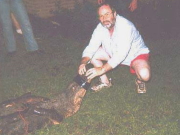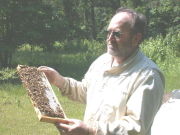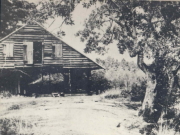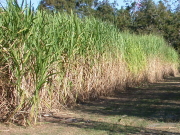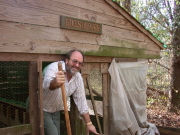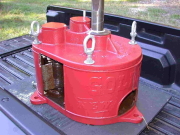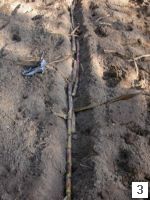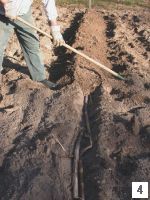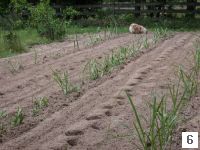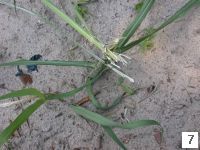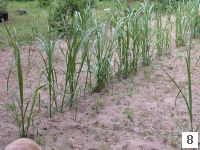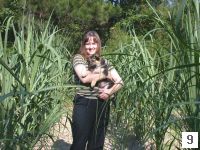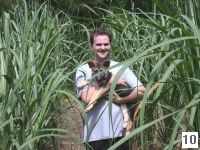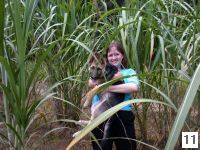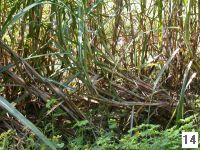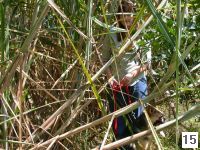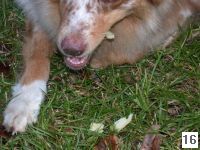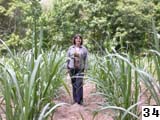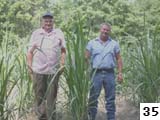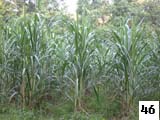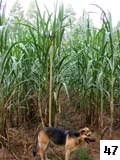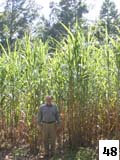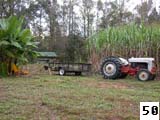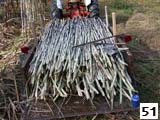Growing Cane
The year after my Grandfather's death, 1960, was a defining one. A sophomore in high school, I had a small independent farming operation on my father's farm. I learned a great deal about the vagaries of farming, weather, and marketing. . . . so much that I took a job working Saturdays and Sundays to pay back my losses. At $6 a 12-hour day, I earned a "man's wage" pumping gas, repairing tires, and servicing vehicles at a service station, another extinct enterprise. After that year, I never gave serious thought to farming for a living although my love for tilling earth never dimmed. In this way, the line between a profession and a hobby was drawn.
In the present context, 1960 was noteworthy because I had my first independent cane patch. The simplicity of that statement belies the implications of how we all have changed. As a first point, Elison Hendley gave me the seed cane. It didn't occur to either of us to talk about price. He was a neighbor; our families had known each other for generations and sharing material and labor was a way of life. In sharp contrast, I have lived in my current house since 1988 (and owned the land since 1982) and have not stepped foot inside another's house within miles. Thus, many of us have lost a sense of community. As a second point, I plowed that cane patch with one of Uncle Cornelius' mules. (It was more trouble to reset my cultivator from 36-inch rows than to borrow his mule.) When I was a small boy, all farmers in our area still had working mules but they had pretty much been displaced by tractors. It is staggering to imagine the technical distance between farming in South Georgia in 1960 and placing a man on the Moon within the decade. It is perhaps even more staggering to consider the achievements between space flight then (based on 64-K computers) and scientific sophistication now, when, for example, we can excise a gene for insect resistance from a bacterium, insert it into a crop plant like corn, and protect the environment by reducing pesticide use. After that cane patch, there was a hiatus of 40 years, except for a few stalks I tended for the fun of it on the edge of my garden.
With the hiatus broken, the purpose of this page is to document the growth of cane over three seasons (2002-2004) in North Florida. Photographs and comments might be added for later years, but only as a supplement. The page does not presume to be a manual, and, indeed, there is little here for anyone who has grown cane.
In this area, the custom is to plant cane in the fall (October or November) or in the spring (March). In the case of fall planting, the cane is placed directly in a furrow after cutting. In the case of spring planting, the cane is banked. (A slightly depressed bed on dry land is covered in straw, the cane is laid on the straw, then the cane is covered first by straw and then a layer of earth, 4-6 inches to prevent freezing). My own schedule is dictated by when I can spare the time. I cut the seed cane the first week of November and planted it three weeks later.
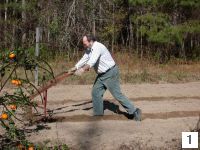 Slide
1 shows the preparation of furrows. I vacillate. Sometimes, I think the
garden plow is the best invention yet, and at other times, . . . . Regardless, I
have had a love-hate relationship with a garden plow since I was a little fellow.
In my prime, I was probably close to 0.1 horsepower; now in my 7th decade,
less.
Slide
1 shows the preparation of furrows. I vacillate. Sometimes, I think the
garden plow is the best invention yet, and at other times, . . . . Regardless, I
have had a love-hate relationship with a garden plow since I was a little fellow.
In my prime, I was probably close to 0.1 horsepower; now in my 7th decade,
less.
As an aside, the Kimbrough satsumas in the foreground are from an old nursery row at the edge of the cane patch. This cultivar was developed in Louisiana from EMS-mutagenized seeds of Owari satsuma. The Kimbrough was released for its superior cold-hardiness, giving it an edge of 1-2 degrees F, a small but sometimes critical difference. These particular plants were budded onto Flying Dragon (a mutant of Poncirus trifoliata), a dwarfing rootstock. Flying Dragon retains positive attributes of the wild-type (conferment of cold-hardiness to the scion, resistance to Phytophthera, and sweetness of fruit), but it is unpredictably dwarfing for citrus and any added cold-hardiness of Kimbrough over other satsumas is in question.
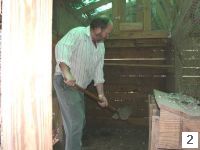 My mother
taught me that dealing with life's tribulations can be made easier by engaging
oneself in non-critical pursuits. Thus, whereas I must make every step count at
my work, I fling logic to the wind when I do something for my personal
entertainment. I know that putting chicken manure (Slide 2)--a
high-nitrogen fertilizer--to sugar cane is not a good idea. Use of it in the
fall, especially in sandy soil as I did, mitigates. I applied at the rate of 2000
pounds/acre in the furrow. (Repeated use of chicken manure is not recommended for
any garden area because of the high copper content.) Anecdotes abound on the use
of any uncomposted manure for sugar cane. It often is blamed for a salty taste or
a general lowering of quality. Since the 2002 syrup (processed at the Griffin Mill) from this cane was excellent in my
opinion, I will not shirk from using a little chicken manure from time to time as
putting manure to vegetables is the culturally, if not scientifically, correct
thing for me to do. Besides, it seems to make the chickens useful.
My mother
taught me that dealing with life's tribulations can be made easier by engaging
oneself in non-critical pursuits. Thus, whereas I must make every step count at
my work, I fling logic to the wind when I do something for my personal
entertainment. I know that putting chicken manure (Slide 2)--a
high-nitrogen fertilizer--to sugar cane is not a good idea. Use of it in the
fall, especially in sandy soil as I did, mitigates. I applied at the rate of 2000
pounds/acre in the furrow. (Repeated use of chicken manure is not recommended for
any garden area because of the high copper content.) Anecdotes abound on the use
of any uncomposted manure for sugar cane. It often is blamed for a salty taste or
a general lowering of quality. Since the 2002 syrup (processed at the Griffin Mill) from this cane was excellent in my
opinion, I will not shirk from using a little chicken manure from time to time as
putting manure to vegetables is the culturally, if not scientifically, correct
thing for me to do. Besides, it seems to make the chickens useful.
The seed cane, obtained from IFAS, was laid in rows with little overlap (Slide 3). This cane was planted, as the extension services recommend, at 3-4 inches deep (Slide 4). Five cultivars were planted (Hybrid No. 14, Hybrid No. 16, CP 36-111, CP 52-48, and CP 67-500). This depth was sufficient for all cultivars except CP 36-111, which, as described later, lodged on my Dothan soil. Some local experts like Ronny Herring plant their cane somewhat deeper.
In the end, my yield was 38,200 pounds/acre or about 70% of the typical commercial yield. As I go through this narrative, I will try to identify reasons for the diminished yield. The first reason was the failure to get a perfect stand. As seed cane, and not land, was limiting, I planted one line, as mentioned above. For fall planting, 1.5-2 lines are generally recommended, although recommendations go as high as 4 lines. For spring planting, the recommended density is less because one culls the stalks that did not overwinter well in the bed.
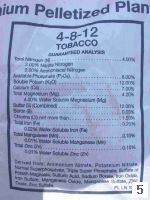 Tobacco
fertlilizer (Slide 5) was applied twice at a total rate of 2000
pounds/acre (about double a typical commercial rate). Sixty percent of this
amount was applied on March 11th and the remainder, June 8th. This choice was
somewhat arbitrary; it clearly would have been preferable to have a soil
analysis. At any rate, maturation of cane is inhibited by high nitrogen,
especially when it is applied late, so tobacco fertilizer is a reasonable choice.
In addition, tobacco fertilizer is low in Cl- (because it affects the burning
quality of leaves) and that seems good. There is always a trade-off; ammonium is
thought by some to lower the quality of the syrup, but nitrate lowers the soil
tilthability over the long term.
Tobacco
fertlilizer (Slide 5) was applied twice at a total rate of 2000
pounds/acre (about double a typical commercial rate). Sixty percent of this
amount was applied on March 11th and the remainder, June 8th. This choice was
somewhat arbitrary; it clearly would have been preferable to have a soil
analysis. At any rate, maturation of cane is inhibited by high nitrogen,
especially when it is applied late, so tobacco fertilizer is a reasonable choice.
In addition, tobacco fertilizer is low in Cl- (because it affects the burning
quality of leaves) and that seems good. There is always a trade-off; ammonium is
thought by some to lower the quality of the syrup, but nitrate lowers the soil
tilthability over the long term.
Slide 6 was taken on April 15th. Slide 7, taken about that time, shows the kind of damage that results from high deer pressure. Such damage created permanent gaps in the guard rows. Indeed, the center row of cane (CP 52-48) produced 445 pounds, compared with 217 pounds for the outside row near the woods (CP 36-111). In short, the second reason for diminished yield was deer. Deer should not be a problem in the future since I have installed a six-foot chain-link fence with three strands of barbed wire all around my property (to keep two-legged vandals off).
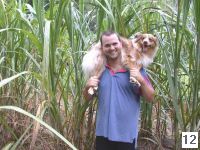 CP 52-48 is shown on May 17th (Slide 8).
My daughter, Elizabeth (then, 24), stands between CP
52-48 (right) and CP-67-500 (left) on June 14th
(Slide 9). Elizabeth, a teacher when this photograph was made, lived
on her own in Georgia. Belle was the first member of
Elizabeth's
CP 52-48 is shown on May 17th (Slide 8).
My daughter, Elizabeth (then, 24), stands between CP
52-48 (right) and CP-67-500 (left) on June 14th
(Slide 9). Elizabeth, a teacher when this photograph was made, lived
on her own in Georgia. Belle was the first member of
Elizabeth's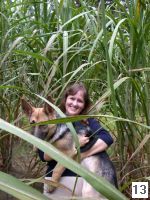 family. My
son, Will (then, 27), holds Belle in the cane patch on June 30th (Slide 10). Will, a resident when this photograph was made, lived on
his own in North Carolina. One month later, July 26th, Elizabeth again shows off
Belle in the cane patch (Slide 11). From this moment forward, Belle became "Donkey" for
obvious reasons. On August 14th, Will is back in the cane patch with Buttley
(Slide 12). (Some years back, Nedra and I gave Will, as a
memento from Volterra, a figurine of a shepherd carrying a goat in this manner as
he often carries the dogs, even the late 92-pound Timber, this way.) By September
1st (Slide 13), it was hard to tell whether Donkey or the cane had grown
the most.
family. My
son, Will (then, 27), holds Belle in the cane patch on June 30th (Slide 10). Will, a resident when this photograph was made, lived on
his own in North Carolina. One month later, July 26th, Elizabeth again shows off
Belle in the cane patch (Slide 11). From this moment forward, Belle became "Donkey" for
obvious reasons. On August 14th, Will is back in the cane patch with Buttley
(Slide 12). (Some years back, Nedra and I gave Will, as a
memento from Volterra, a figurine of a shepherd carrying a goat in this manner as
he often carries the dogs, even the late 92-pound Timber, this way.) By September
1st (Slide 13), it was hard to tell whether Donkey or the cane had grown
the most.
On September 14th, Hanna dropped a great deal of rain, but no wind. Slide 14, taken September 22nd, shows that CP 36-111 fell over into a tangled mess. As alluded to earlier, experienced growers indicate that this cultivar does not lodge if planted deeply. Slide 15 was taken days before harvest (November 2nd).
Slide 16, just for the fun of it, shows Buttley enjoying sugar cane in its purist form. . . .and, yes, I did sit down and peel and quarter the cane for her as I did for my children and as my grandfather did for us children.
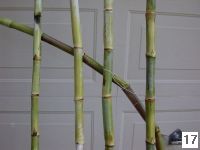 Stalks of the five canes (l-r, Hybrid No. 16,
Hybrid No. 14, CP
Stalks of the five canes (l-r, Hybrid No. 16,
Hybrid No. 14, CP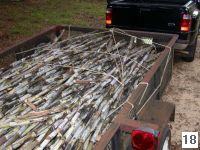 67-500, CP 52-48 and CP 36-111) are
shown in Slide 17. Hybrid No. 16 is far too difficult to strip and not
especially productive (4 pounds per linear foot); I've dug up the stubble and
discarded it. Hybrid No. 14 was easily the most productive (nearly 10 pounds per
linear foot), but it has a small diameter, making extraction on vintage mills
somewhat problematic. I eventually discarded it, and continued to evaluate the
Canal Point canes. Slide 18
shows the harvested cane on its way to the mill.
67-500, CP 52-48 and CP 36-111) are
shown in Slide 17. Hybrid No. 16 is far too difficult to strip and not
especially productive (4 pounds per linear foot); I've dug up the stubble and
discarded it. Hybrid No. 14 was easily the most productive (nearly 10 pounds per
linear foot), but it has a small diameter, making extraction on vintage mills
somewhat problematic. I eventually discarded it, and continued to evaluate the
Canal Point canes. Slide 18
shows the harvested cane on its way to the mill.
In the preceding, I have mentioned that a
less-than-perfect stand (because of planting density and deer) diminished the
yield. Use of some of the current season cane to fill the gaps also diminished
harvested yield somewhat. The remaining (and major) detriment was a live oak tree
that robbed the cane of nutrients and of light until about noon. Many plants are
tolerant of shade at least at some stages of growth. Others, including such
C4 plants as sugar cane, sorghum, and corn, are not. C4
plants have an auxiliary photosynthetic pathway that is compartmented in a
separate type of cell. This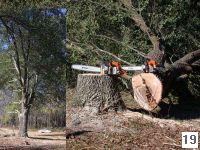 compartmentation makes them
highly productive in high light, but causes them to compete poorly in low light
or at low temperatures. The choice of having the oak tree or sugar cane was not
easy, but Slide 19 proves that sugar cane won. The tree was located
around valuables (garage, satsumas, and figs to the south and west and loquats
and figs to the south and east), restricting my only choice of falling to the
north. Because the north faced the woods, that side of the tree had not filled
out so well, requiring climbing and trimming on the opposite side (see arrows in
the left panel of Slide 19). The redistribution of weight and a come-along dropped the
tree handily. The tree did not entirely lose its value, though, as Will and I
used the wood for a barbeque over his spring break.
compartmentation makes them
highly productive in high light, but causes them to compete poorly in low light
or at low temperatures. The choice of having the oak tree or sugar cane was not
easy, but Slide 19 proves that sugar cane won. The tree was located
around valuables (garage, satsumas, and figs to the south and west and loquats
and figs to the south and east), restricting my only choice of falling to the
north. Because the north faced the woods, that side of the tree had not filled
out so well, requiring climbing and trimming on the opposite side (see arrows in
the left panel of Slide 19). The redistribution of weight and a come-along dropped the
tree handily. The tree did not entirely lose its value, though, as Will and I
used the wood for a barbeque over his spring break.
Returning from the stubble is an important quality of cane, so I offer a brief follow-up for the second year, as shown by photographs made on August 2, 2003. As was the case for some of the photographs made during the plant-cane season (above), my son, Will, provides perspective; we had just returned from the bees. Hybrid No. 14 grew vigorously as plant cane, as discussed above, and it came back from the stubble well, too. Will holds Priss (b. 05/03) in front of Hybrid No. 14 (Slide 20). CP 52-48 also grew vigorously as plant cane, averaging about six pounds per linear foot. This cane came back from the stubble well, too. Will holds a "cane-patch" cottonmouth (Slide 21) in front of CP 52-48. Although the snake was still trying to flex, it was mostly spent. Buttley (Slides 12 & 16) is a grave danger to snakes, and ordinarily she assaults without delay: she sails into the snake, clamps its body in the center, and by stunningly fast and robust head motions literally flails it to death. I realized she had found a snake, but she seemed to be jockeying for position. I saw the shape through the grass well enough to understand-it was coiled. Once I hit it with a post, the rest was up to Buttley (and Will, who delivered the coup de grâce). I do wish she wouldn't bother poisonous snakes because she will not be fast enough one day. I also wish she wouldn't bother nonpoisonous snakes because they are nice to have around. My opinions don't seem to matter too much to Buttley, though, as she killed two other snakes in our backyard later in the afternoon.
(Although it strays from the point a little, a cottonmouth begins life as a cute little snake. Like its congener, the copperhead, it has a bronze-colored head and a sulfur tail that wags, emulating a worm and thus attracting prey. As it grows older, the bright coloration is lost and the spots become less distinct. It becomes increasingly darker (see Slide 21). In the end, the bulls like one would step over or paddle around in the bays around home were fat (usually) and practically black. Growing up, I was worse than average about trapping fish using, of course, the single-coned (illegal) traps that retained warmouths and bream, none large. These traps also retained (and drowned) cottonmouths making it easy to remember to retrieve a trap using a piece of tied-off baling wire or to lift free traps with a tobacco stick. You might be told on good authority that these are timid snakes, but the fact is, they stand their ground. Although I can’t support claims about outright aggression, I have had them crawl toward me when I bothered them. Evolution failed to equip cottonmouths with a fear of humans.)
In the third season of my sugar-cane
revival, I decided to expand my planting. By this time, C.P. 67-500 had emerged
as a favorite cultivar. Although seed cane for this cultivar is available
locally, purchasing it from Poplarville (Slide
22, South Mississippi Branch Experiment Station) was intended to give me
the opportunity to tromp around in Broadhead's former haunts, indeed, a kind of
spiritual pilgrimage. 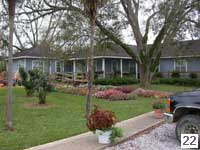 Broadhead,
whose bulletin on sugar-cane syrup production I have found extremely
useful, was a sweet-sorghum and sugar-cane breeder and field experimentalist. I
agree with Thomas Jefferson on one point: "The greatest service which can be
rendered any country is to add a useful plant to its culture." Among the
contributions made by Broadhead and his collaborators are sorghum varieties
(Grassl, Smith, Cowley, Keller, M81E, Wray, Theis, Ramada, Rio, Dale, Brades) and
C.P. 67-500 sugar cane. Unfortunately, the mission of the station had changed
since his time, and, as far as I could tell, the tradition I sought was absent.
Too bad for me: my boundless reverence lost its target. Still and all, I was
grateful to meet Mike Anderson (Slide
23) and his field crew and obtain the seed cane.
Broadhead,
whose bulletin on sugar-cane syrup production I have found extremely
useful, was a sweet-sorghum and sugar-cane breeder and field experimentalist. I
agree with Thomas Jefferson on one point: "The greatest service which can be
rendered any country is to add a useful plant to its culture." Among the
contributions made by Broadhead and his collaborators are sorghum varieties
(Grassl, Smith, Cowley, Keller, M81E, Wray, Theis, Ramada, Rio, Dale, Brades) and
C.P. 67-500 sugar cane. Unfortunately, the mission of the station had changed
since his time, and, as far as I could tell, the tradition I sought was absent.
Too bad for me: my boundless reverence lost its target. Still and all, I was
grateful to meet Mike Anderson (Slide
23) and his field crew and obtain the seed cane.
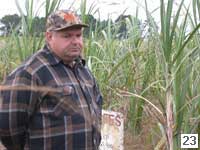 The
seed cane and new area prompted me to have a soil test made (Slide 24). I had expected that my soil would need pH adjustment and
amendments. Although my area of Florida, the Red Hills, is reasonably fertile
sandy loam, most Florida soil is poor. (One UF Dean of Agriculture is reported to
have quipped that farming in Florida is simple-just add seed, water, and all the
required nutrients!) Nitrogen and potassium deficiency is the norm for most
soils.
The
seed cane and new area prompted me to have a soil test made (Slide 24). I had expected that my soil would need pH adjustment and
amendments. Although my area of Florida, the Red Hills, is reasonably fertile
sandy loam, most Florida soil is poor. (One UF Dean of Agriculture is reported to
have quipped that farming in Florida is simple-just add seed, water, and all the
required nutrients!) Nitrogen and potassium deficiency is the norm for most
soils.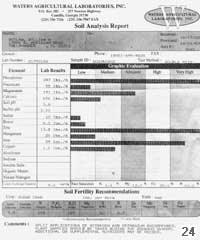 However, I
was a bit surprised that my soil was limited in sulfur. Sulfur is required in
many many biochemical processes, notably as amino acids that are used for
proteins or peptides that serve as catalysts, structural elements and as redox
signals. Non-protein sulfur-containing amino acids are also made by plants,
giving, for example, onions pungency. I had expected boron deficiency as my
turnips grown in this location had suffered from water core.
However, I
was a bit surprised that my soil was limited in sulfur. Sulfur is required in
many many biochemical processes, notably as amino acids that are used for
proteins or peptides that serve as catalysts, structural elements and as redox
signals. Non-protein sulfur-containing amino acids are also made by plants,
giving, for example, onions pungency. I had expected boron deficiency as my
turnips grown in this location had suffered from water core.
November 11th is a somber but joyous day
for much of western civilization, but, like the bereaved of so long ago, I am not
a party to this cheeriness: it was the day my father died in 1986. And, it was
also the day in 2003 that my little Buttley was nailed by a cottonmouth as I had
feared (see above). Little Buttley and I had been grinding cane (which the
Brinsons
reduced to syrup for me) and we were using the pomace to mulch a banana (Slide
25).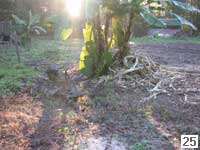 (My mind wanders a bit: this banana is the new tetraploid cultivar
GoldFinger, which I purchased on a visit to Don and Katie Chafin's excellent nursery.
I've trialed several bananas, and this one along with Raja Puri and Orinoco (a
plantain you might say) would to be on the must-have list for marginal
environments.) While I was doing the main part of the work, Buttley, ever nosey,
started a ruckus by a lightwood stump (foreground in Slide 25) that I was saving for smoker fuel. Having
my mind in its usual disengaged position, I pushed the stump over a bit with my
foot and the tilt was sufficient for Buttley to get her head under the stump.
(My mind wanders a bit: this banana is the new tetraploid cultivar
GoldFinger, which I purchased on a visit to Don and Katie Chafin's excellent nursery.
I've trialed several bananas, and this one along with Raja Puri and Orinoco (a
plantain you might say) would to be on the must-have list for marginal
environments.) While I was doing the main part of the work, Buttley, ever nosey,
started a ruckus by a lightwood stump (foreground in Slide 25) that I was saving for smoker fuel. Having
my mind in its usual disengaged position, I pushed the stump over a bit with my
foot and the tilt was sufficient for Buttley to get her head under the stump.
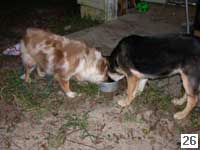 I didn't see the snake bite her, but she
communicated that it did--she usually flails a while and pauses to see if the
snake has life, but in this case, she was relentless. She was in Bradfordville
Animal Hospital within 20 minutes and Dr. Steverson administered
antivenom.
I didn't see the snake bite her, but she
communicated that it did--she usually flails a while and pauses to see if the
snake has life, but in this case, she was relentless. She was in Bradfordville
Animal Hospital within 20 minutes and Dr. Steverson administered
antivenom.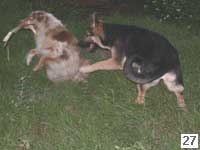 I
was fearful that I might lose one of my sugar-cane buddies, shown for emphasis
drinking cane juice (Slide
26) and tussling with Priss over pomace (Slide 27). After a night at Allied Veterinarians' Emergency
Hospital, her swelling had subsided (Slide
28), but it was weeks she before returned to her normal self, yes--meaning
leaving dead snakes at the garage. She would seem incorrigible, but fortunately,
she called for my help with this dangerous
fellow. (. . . my
I
was fearful that I might lose one of my sugar-cane buddies, shown for emphasis
drinking cane juice (Slide
26) and tussling with Priss over pomace (Slide 27). After a night at Allied Veterinarians' Emergency
Hospital, her swelling had subsided (Slide
28), but it was weeks she before returned to her normal self, yes--meaning
leaving dead snakes at the garage. She would seem incorrigible, but fortunately,
she called for my help with this dangerous
fellow. (. . . my -t.jpg) apologies for two points: (a) although I make it seem that I take
pleasure in killing snakes, that is not true. I am happy to share out areas with
them, but poisonous snakes near my house are a hazard to my dogs, which I prize
more. [In some ways, living on property with so many poisonous snakes is a kind
of comfort since tromping around my house at night without a light would be a
pretty foolish thing to do.] (b) this particular snake was rearranged
significantly by the only thing I had handy, which was more along the lines of
stopping a 200-lb animial than a nominal 10-lb animal. Although out of the
context of cane, another photograph shows a diamond back with life ebbing away after a more gentle perturbation.)
apologies for two points: (a) although I make it seem that I take
pleasure in killing snakes, that is not true. I am happy to share out areas with
them, but poisonous snakes near my house are a hazard to my dogs, which I prize
more. [In some ways, living on property with so many poisonous snakes is a kind
of comfort since tromping around my house at night without a light would be a
pretty foolish thing to do.] (b) this particular snake was rearranged
significantly by the only thing I had handy, which was more along the lines of
stopping a 200-lb animial than a nominal 10-lb animal. Although out of the
context of cane, another photograph shows a diamond back with life ebbing away after a more gentle perturbation.)
In this same time frame, I limed the new
cane patch, tilled it and laid out the rows. Whereas Buttley-at 35 pounds-fancies
herself as the hunter, estate mistress, and general guardian, Priss, like the
late Timber (another German Shepherd), is slouchy and gravitates toward farming,
in short, my female complement. Priss' enthusiasm exceeds her understanding of
farming, though. Slide 29 shows her covering up the rows as fast as I could
lay them out. I have finally convinced 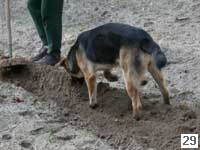 her not to go into the cane patch when I am
around, but paw prints give her away-she is responsible for digging up the cane
and for chewing sprouts off. She is incorrigible, too, perhaps ignorant and
attempting to emulate my activities, or she may be simply throwing a spanner in
the works. I wouldn't place money against either of those conjectures.
her not to go into the cane patch when I am
around, but paw prints give her away-she is responsible for digging up the cane
and for chewing sprouts off. She is incorrigible, too, perhaps ignorant and
attempting to emulate my activities, or she may be simply throwing a spanner in
the works. I wouldn't place money against either of those conjectures.
The C.P. 67-500 was planted in two lines, as were rows of ribbon cane, of purple cane (for both, thanks to Don Dean) and of Home Green cane (thanks to Keefee and friends). (These last three varieties were cut without the notion that they would serve as seed, so the stalks were stripped, damaging some "eyes." Never mind, however, since my purpose was to amplify the cane, not use it for harvest.) At the same time, I maintained a row of C.P. 36-111 and C.P. 52-48 and a couple of other cultivars in the old cane patch. In the middle of April, I formulated and applied a fertilizer mix (ammonium nitrate, ammonium sulfate and potash) that supplied half of the season's nitrogen and potassium needs and all the season's sulfur needs. The remainder of the nitrogen and potassium requirements were added the first week of July.
As one might expect, putting in the new cane patch involved
more than planting the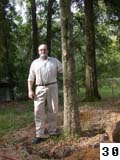 cane. I removed
as much shade as my marriage would tolerate. Slides 30
and 31 show my preferred way of removing shade; I took down the larger
tree in the background with a saw. Altogether, this work opened the patch some,
but not enough. At the time of this writing (Summer, 2006), I still have a good
bit of shade from a willow oak
cane. I removed
as much shade as my marriage would tolerate. Slides 30
and 31 show my preferred way of removing shade; I took down the larger
tree in the background with a saw. Altogether, this work opened the patch some,
but not enough. At the time of this writing (Summer, 2006), I still have a good
bit of shade from a willow oak 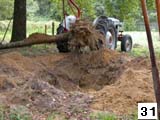 and from a hickory. Time will
tell—I like both trees and expect to move my cane patch to a more sunny
area and return the cane patch to its former duty as a garden.
and from a hickory. Time will
tell—I like both trees and expect to move my cane patch to a more sunny
area and return the cane patch to its former duty as a garden.
Gardening was not all lost, however, as the wide spacing of
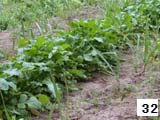 cane permits getting double duty from a cane patch, as shown by the
turnips in Slide 32, which was taken in April. (Although it is not
optimal, December 29 is my target day for planting greens. As this date is my
sister’s birthday, it is easy to remember and doing the bulk of the growth
over winter and very early spring obviates the use of pesticides.) The open
pollinated cultivar
cane permits getting double duty from a cane patch, as shown by the
turnips in Slide 32, which was taken in April. (Although it is not
optimal, December 29 is my target day for planting greens. As this date is my
sister’s birthday, it is easy to remember and doing the bulk of the growth
over winter and very early spring obviates the use of pesticides.) The open
pollinated cultivar 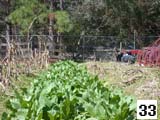 (Slide 32) takes about a month longer than a hybrid (Just
Rite) that I perfer (Slide 33) because of its taste and maturity before the cane comes
up. There is, of course, a conflict with growing greens this way since greens
demand high nitrogen. Along the same vein, potatoes were historically planted in
cane middles, but potatoes perform better is a lower pH soil than does cane.
Eventually, when I move my cane patch to a larger area, I expect to plant two
rows at normal spacing and then leave an empty row for legumes, which also have
low nutrient demands. The “empty” row, of course, will be convenient
for harvesting the cane (cf. the system used by Junior Cashwell). I hasten to add that nothing said implies that I
ever plan to make much syrup. It is too much work.
(Slide 32) takes about a month longer than a hybrid (Just
Rite) that I perfer (Slide 33) because of its taste and maturity before the cane comes
up. There is, of course, a conflict with growing greens this way since greens
demand high nitrogen. Along the same vein, potatoes were historically planted in
cane middles, but potatoes perform better is a lower pH soil than does cane.
Eventually, when I move my cane patch to a larger area, I expect to plant two
rows at normal spacing and then leave an empty row for legumes, which also have
low nutrient demands. The “empty” row, of course, will be convenient
for harvesting the cane (cf. the system used by Junior Cashwell). I hasten to add that nothing said implies that I
ever plan to make much syrup. It is too much work.
A series of slides illustrate stages of development of plant C.P 67-500 at different times of the year. Nedra serves as a scale on May 29 (Slide 34). On June 10 (Slide 35), Charles Baldree and his son-in-law, Billy Bannon, serve as the scale whereas I do the duty on Jun 30 (Slide 36) and Anthony Brinson does it on Jul 6 (Slide 37). Rounding out the series, Liz and Belle pose on Aug 6 (Slide 38)
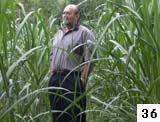 |
|||||||
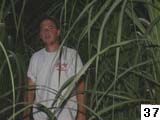 |
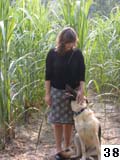 |
Hurricane Frances dumped a lot of rain, but
carried little wind, in September (2004). As Slide 39
shows, C.P 67-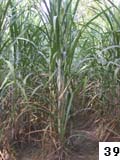 500 stood up well, as did
C.P 52-48 (Slide 40). [As the comparison demonstrates, I get better stooling
from C.P 52-48 than I do from
500 stood up well, as did
C.P 52-48 (Slide 40). [As the comparison demonstrates, I get better stooling
from C.P 52-48 than I do from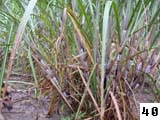 C.P 67-500.] For a
better view of the bore of C.P 67-500 at this time of the year, click
here. For a view of Eyespot Disease on the leaves, click here.] On the other hand, Hybrid 14 was a tangled mess
(Slice 41). The propensity to lodge, the small bore, and the low brix
(later) spelt the end of this cultivar for me. C.P. 36-111 (not shown) also
lodged
C.P 67-500.] For a
better view of the bore of C.P 67-500 at this time of the year, click
here. For a view of Eyespot Disease on the leaves, click here.] On the other hand, Hybrid 14 was a tangled mess
(Slice 41). The propensity to lodge, the small bore, and the low brix
(later) spelt the end of this cultivar for me. C.P. 36-111 (not shown) also
lodged 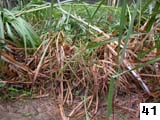 badly; I have
used different planting depths and hilling protocols, and my experience is always
the same: this cultivar lodges and is less productive than C.P 52-48 and C.P
67-500. Of course, my sample size is small and others might have entirely
different experiences. As far as I know, the only advantage C.P 36-111 has over
other cultivars is the production of lighter-colored mild syrup, which is not my
goal. So, I phased it out following Dennis (an early hurricane in 2005), which
blew it over and broke it off at the joints.
badly; I have
used different planting depths and hilling protocols, and my experience is always
the same: this cultivar lodges and is less productive than C.P 52-48 and C.P
67-500. Of course, my sample size is small and others might have entirely
different experiences. As far as I know, the only advantage C.P 36-111 has over
other cultivars is the production of lighter-colored mild syrup, which is not my
goal. So, I phased it out following Dennis (an early hurricane in 2005), which
blew it over and broke it off at the joints.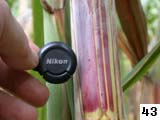
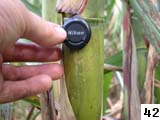 Home Green (Slide 42) and
(blue) Ribbon (Slide 43) cane
are two cultivars of historical interest and, of course, that is sufficient reason
for me to plant them even though both suffer from terrible disadvantages of
failing to return reliably from stubble, being susceptible to biotic and abiotic
stresses and having relatively low brix (which increases the energy, cost, and
time of making syrup).
Home Green (Slide 42) and
(blue) Ribbon (Slide 43) cane
are two cultivars of historical interest and, of course, that is sufficient reason
for me to plant them even though both suffer from terrible disadvantages of
failing to return reliably from stubble, being susceptible to biotic and abiotic
stresses and having relatively low brix (which increases the energy, cost, and
time of making syrup).
. . .but, when 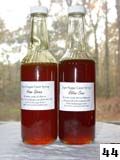 Nedra tells me
that the dab of ribbon syrup I make is just like she had as a child, except
better, I am good for another season (Slide 44).
Nedra tells me
that the dab of ribbon syrup I make is just like she had as a child, except
better, I am good for another season (Slide 44).
In summary, in Fall, 2001, I planted 5 sugar-cane
cultivars that are available from and recommended locally by the experiment
station for syrup production.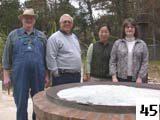 I took that crop to the
Griffin Mill in Alapaha, and Jerry, Linda, and Robert Earl ground
the cane on their then "new" Chattanooga No. 44 (old style) and made syrup. By
2003, I was able to grind the cane at my home, and Jerry and Anthony Brinson made syrup from my juice. Finally, in
2004, the entire operation could be done at my house. The inaugural cooking
(Slide
45) used the talents and enthusiasm of friends Zack Hicks, Leon Robinson,
student Yun Kang, and my spouse, Nedra, of course. Over these years, on the basis
of my personal experience under my conditions, I eliminated Hybrid No. 14, Hybrid
No. 16, and C.P. 36-111 from my planting. I also eliminated Cold Hardy No. 8,
which was obtained as a chewing cane, but have retained a short row of C.P.
31-511. My focus is on C.P. 67-500 and C.P. 52-48, but I also have a small amount
of Home Green, Ribbon, and Louisiana Purple.
I took that crop to the
Griffin Mill in Alapaha, and Jerry, Linda, and Robert Earl ground
the cane on their then "new" Chattanooga No. 44 (old style) and made syrup. By
2003, I was able to grind the cane at my home, and Jerry and Anthony Brinson made syrup from my juice. Finally, in
2004, the entire operation could be done at my house. The inaugural cooking
(Slide
45) used the talents and enthusiasm of friends Zack Hicks, Leon Robinson,
student Yun Kang, and my spouse, Nedra, of course. Over these years, on the basis
of my personal experience under my conditions, I eliminated Hybrid No. 14, Hybrid
No. 16, and C.P. 36-111 from my planting. I also eliminated Cold Hardy No. 8,
which was obtained as a chewing cane, but have retained a short row of C.P.
31-511. My focus is on C.P. 67-500 and C.P. 52-48, but I also have a small amount
of Home Green, Ribbon, and Louisiana Purple.
Thanks for your patience.
*******************************************
2005 Supplement
Noting that most of the images of cane growing above were from earlier in the season, I have added a supplement for 2005. Slide 46 of C.P. 67-500 was taken July 29; Slide 47, August 19; Slide 48, Sep 7; Slide 49 of C.P. 52-48, Sep 23; Slide 50 of C.P. 67-500 again, at harvest Nov 25; Slide 51, 500 stalks of C.P. 67-500 in the bed of an 8-ft trailer--more than enough for a 60-gallon kettle of juice (which holds only 55 gallons to the mid-way of the flange).
When Slide 46 was made, the cane was weedy. Note that I trim the lower leaf blades off and using a guard, spray Round-up to clean the middles (Slide 47), but strictly avoid any contact with cane. To my knowledge, no contact herbicide or soil treatment is labeled for sugar cane that is used to make syrup. ("The label is the law.") Of course, this means of controlling weeds works well for a small sideliner, but might not for one who grows much cane.
Also note again the better stooling with C.P 52-48 (Slide 49) than with C.P. 67-500 (the other slides).
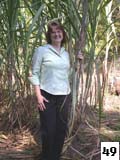 |
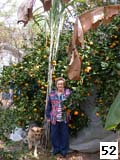 2005 was a fun year for cane, but it was a fastistic year for
the dooryard citrus producer in North Florida. Slide 52 shows a part of my satsuma trees as well as the
syrup shed in the background. My sister, Carolyn, provides perspective. The two
satsumas in that spot made about 300 lbs. of fruit each! 2005 also marked the
enclosure of my kettle, and Ken Christison has graciously documented my first inside cooking.
There, one would see quite a syrup gang-
2005 was a fun year for cane, but it was a fastistic year for
the dooryard citrus producer in North Florida. Slide 52 shows a part of my satsuma trees as well as the
syrup shed in the background. My sister, Carolyn, provides perspective. The two
satsumas in that spot made about 300 lbs. of fruit each! 2005 also marked the
enclosure of my kettle, and Ken Christison has graciously documented my first inside cooking.
There, one would see quite a syrup gang-_1.jpg) -Ken's spouse, Connie, in
light blue; my spouse, Nedra; Anthony Brinson, in the jeans jacket; Charles
Deese, in two-toned jacket; and Leon Robinson. Ken, so busy photographing, is not
shown. In contrast, my second cooking in 2005 (Slide
53) was done solo, except my daughter, Elizabeth, and her husband, John
Crawford, assisted with bottling.
-Ken's spouse, Connie, in
light blue; my spouse, Nedra; Anthony Brinson, in the jeans jacket; Charles
Deese, in two-toned jacket; and Leon Robinson. Ken, so busy photographing, is not
shown. In contrast, my second cooking in 2005 (Slide
53) was done solo, except my daughter, Elizabeth, and her husband, John
Crawford, assisted with bottling.
*******************************************
